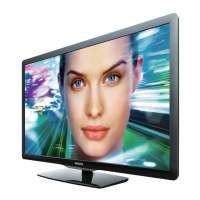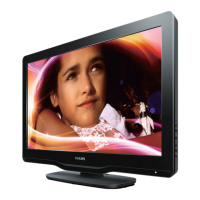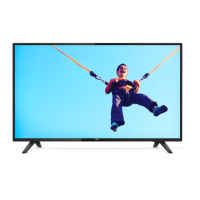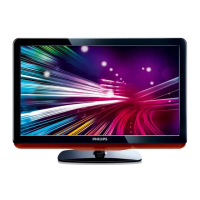Do you have a question about the Philips JL2.1E and is the answer not in the manual?
Details on display type, screen size, resolution, contrast ratio, light output, response time, viewing angle, tuning system, colour systems, computer formats, video formats, AV input, and tuner bands.
Overview of side and rear connections, including Headphone, Cinch (Video CVBS, Audio), SVHS, HDMI, DVI-I, Digital Audio, EXT1, EXT2, EXT3, EXT4, RJ45 Ethernet.
Identifies the physical locations of main Printed Wiring Boards (PWBs) within the chassis for different models (32", 37", 42").
Outlines safety regulations for repairs, including isolation transformer usage, replacement of safety components, correct routing of wires, and cabinet checks.
Alerts to hazards like electrostatic discharge (ESD), high voltage sections, working with the unit "on", and using non-metallic tools for alignment.
Provides general notes on measurement conditions, schematic conventions, and specific instructions for rework on BGA ICs.
Explains how to download and perform automatic and manual software upgrades using a USB portable memory device.
Covers cable dressing, PWB disassembly, and display removal procedures.
Explains how to place the TV in a service position for easier access to internal components.
Provides instructions for reassembling the TV set after servicing, ensuring cables are correctly placed and connections are secured.
Explains the use of test points for diagnostics and controlling test patterns via ComPair.
Introduces Service Default Mode (SDM), Service Alignment Mode (SAM), and Customer Service Mode (CSM).
Explains the stepwise start-up method, including flowcharts for transitions between power states.
Describes essential service tools like ComPair and the LVDS tool for diagnostics and repair.
Explains the error buffer, how to read/clear errors, and provides detailed information on specific error codes.
Details the procedure for using the blinking LED as a diagnostic tool to identify errors.
Explains software and hardware protections related to supplies, safety mechanisms, and audio DC protection.
Provides a first-line fault finding tree for common operational issues and repair advice.
Details procedures for upgrading main software via USB and stand-by software via PC and ComPair interface.
Provides wiring diagrams for different LCD models (32", 37", 42"), showing interconnections between boards.
Illustrates block diagrams for Power Supply, Video, Audio, Control, I2C overview, and signal lines.
Contains circuit diagrams for the Mains Filter, Standby, and Supply sections for various LCD models (32", 37", 42" v2, v3).
Details circuit diagrams for major SSB components like Interface Panel, Ambi Light, DC/DC converters, Tuners, MPIF, PNX2015, VIPER, SPIDER, and NAND Flash.
Shows the physical layout of SSB components for various versions (v2, v3) on both top and bottom sides.
Outlines conditions for performing electrical adjustments, including power supply voltage, isolation transformer, and test probe specifications.
Details hardware alignments, specifically the Backlight Voltage Alignment.
Explains how to access SAM mode for software alignments, including IF PLL Offset and White D.
Covers configuration settings, including Dealer Options, Service Options, and Option Numbers.
Introduces the chassis development name "Jaguar" and highlights key components like MPIF, AVIP, SPIDER, VIPER, and MOP.
Describes general characteristics, block diagram, start-up sequence, power states, and DC/DC converters.
Provides voltage specifications and power distribution overviews for different operating modes.
Details the chassis' USB 2.0 and HDMI interfaces, including their functionalities and specifications.
Introduces the MPIF IC and explains its IF processing, source selection, and signal flow.
Explains the AVIP's role in input decoding, video processing, and audio processing.
Introduces the COLUMBUS block for picture improvement functions like combing and noise reduction.
Details LVDS signaling, its advantages over standard signals, and temporal upconversion for SD signals.
Explains the stand-by processor's functions, including remote control handling, power supply protection, and start-up sequence.
Introduces the SPIDER as a video co-processor responsible for temporal noise reduction and de-interlacing.
Introduces the PNX8550 as a media processor with capabilities for video enhancement, scaling, and Ambilight processing.
Provides a comprehensive list of abbreviations used throughout the document for easy reference.
Shows internal block diagrams and pin configurations for key ICs like AVS1ACP08, MC34067P, PNX3000HL, and others.
Lists various general components and their part numbers, including card readers, stands, and cables.
Provides a detailed list of spare parts for the LCD Supply Panel (32"), including fuses, connectors, and transformers.
Details on display type, screen size, resolution, contrast ratio, light output, response time, viewing angle, tuning system, colour systems, computer formats, video formats, AV input, and tuner bands.
Overview of side and rear connections, including Headphone, Cinch (Video CVBS, Audio), SVHS, HDMI, DVI-I, Digital Audio, EXT1, EXT2, EXT3, EXT4, RJ45 Ethernet.
Identifies the physical locations of main Printed Wiring Boards (PWBs) within the chassis for different models (32", 37", 42").
Outlines safety regulations for repairs, including isolation transformer usage, replacement of safety components, correct routing of wires, and cabinet checks.
Alerts to hazards like electrostatic discharge (ESD), high voltage sections, working with the unit "on", and using non-metallic tools for alignment.
Provides general notes on measurement conditions, schematic conventions, and specific instructions for rework on BGA ICs.
Explains how to download and perform automatic and manual software upgrades using a USB portable memory device.
Covers cable dressing, PWB disassembly, and display removal procedures.
Explains how to place the TV in a service position for easier access to internal components.
Provides instructions for reassembling the TV set after servicing, ensuring cables are correctly placed and connections are secured.
Explains the use of test points for diagnostics and controlling test patterns via ComPair.
Introduces Service Default Mode (SDM), Service Alignment Mode (SAM), and Customer Service Mode (CSM).
Explains the stepwise start-up method, including flowcharts for transitions between power states.
Describes essential service tools like ComPair and the LVDS tool for diagnostics and repair.
Explains the error buffer, how to read/clear errors, and provides detailed information on specific error codes.
Details the procedure for using the blinking LED as a diagnostic tool to identify errors.
Explains software and hardware protections related to supplies, safety mechanisms, and audio DC protection.
Provides a first-line fault finding tree for common operational issues and repair advice.
Details procedures for upgrading main software via USB and stand-by software via PC and ComPair interface.
Provides wiring diagrams for different LCD models (32", 37", 42"), showing interconnections between boards.
Illustrates block diagrams for Power Supply, Video, Audio, Control, I2C overview, and signal lines.
Contains circuit diagrams for the Mains Filter, Standby, and Supply sections for various LCD models (32", 37", 42" v2, v3).
Details circuit diagrams for major SSB components like Interface Panel, Ambi Light, DC/DC converters, Tuners, MPIF, PNX2015, VIPER, SPIDER, and NAND Flash.
Shows the physical layout of SSB components for various versions (v2, v3) on both top and bottom sides.
Outlines conditions for performing electrical adjustments, including power supply voltage, isolation transformer, and test probe specifications.
Details hardware alignments, specifically the Backlight Voltage Alignment.
Explains how to access SAM mode for software alignments, including IF PLL Offset and White D.
Covers configuration settings, including Dealer Options, Service Options, and Option Numbers.
Introduces the chassis development name "Jaguar" and highlights key components like MPIF, AVIP, SPIDER, VIPER, and MOP.
Describes general characteristics, block diagram, start-up sequence, power states, and DC/DC converters.
Provides voltage specifications and power distribution overviews for different operating modes.
Details the chassis' USB 2.0 and HDMI interfaces, including their functionalities and specifications.
Introduces the MPIF IC and explains its IF processing, source selection, and signal flow.
Explains the AVIP's role in input decoding, video processing, and audio processing.
Introduces the COLUMBUS block for picture improvement functions like combing and noise reduction.
Details LVDS signaling, its advantages over standard signals, and temporal upconversion for SD signals.
Explains the stand-by processor's functions, including remote control handling, power supply protection, and start-up sequence.
Introduces the SPIDER as a video co-processor responsible for temporal noise reduction and de-interlacing.
Introduces the PNX8550 as a media processor with capabilities for video enhancement, scaling, and Ambilight processing.
Provides a comprehensive list of abbreviations used throughout the document for easy reference.
Shows internal block diagrams and pin configurations for key ICs like AVS1ACP08, MC34067P, PNX3000HL, and others.
Lists various general components and their part numbers, including card readers, stands, and cables.
Provides a detailed list of spare parts for the LCD Supply Panel (32"), including fuses, connectors, and transformers.












